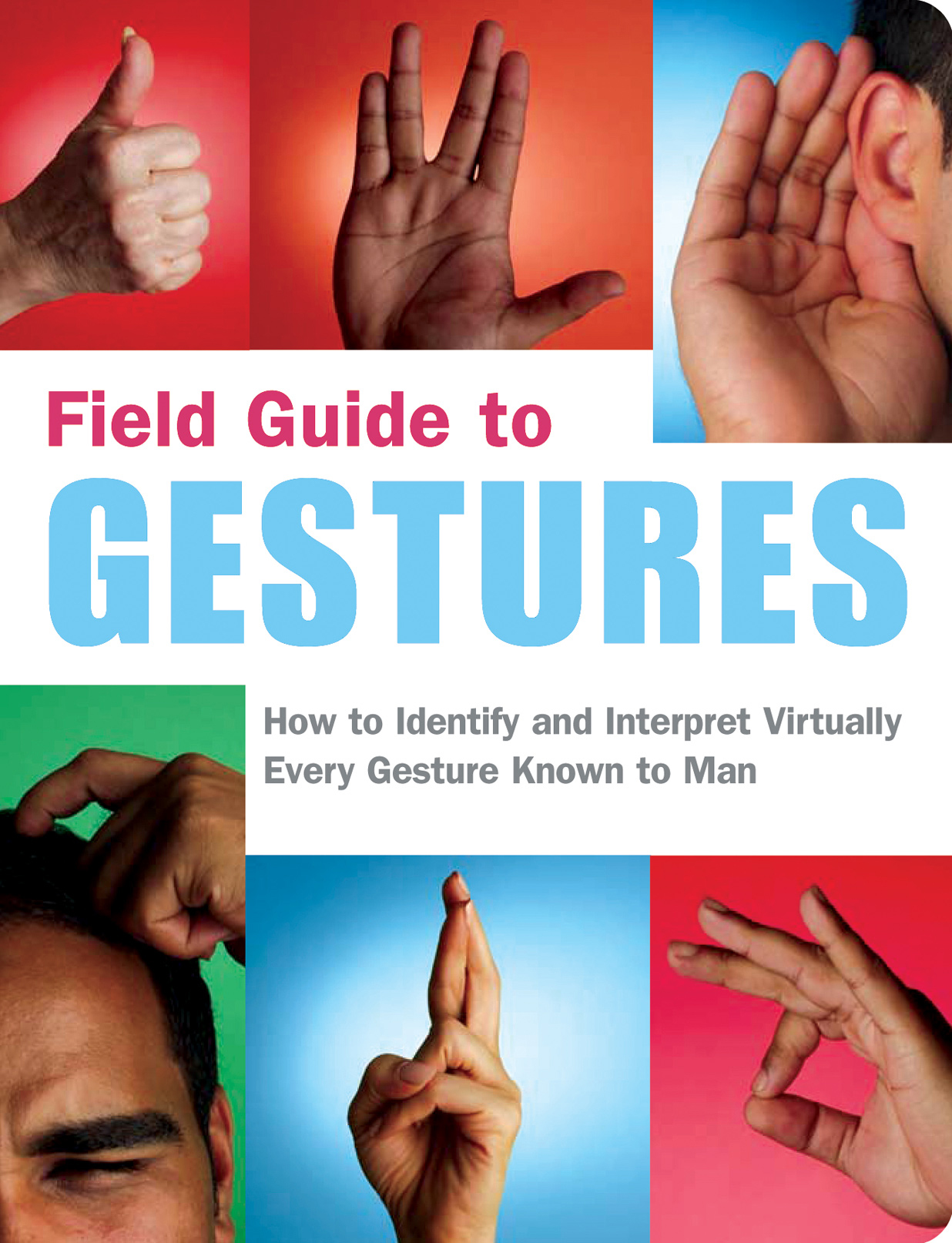DISCLAIMER
There are millions of gestures in the world and even more interpretations. While every care has been taken to represent the most popular gestures and to explain their meanings worldwide, the authors and publisher cannot guarantee that this guide addresses every variation of meaning or every gesture in the world.
Copyright 2003 by Quirk Productions, Inc.
All rights reserved. No part of this book may be reproduced in any form without written permission from the publisher.
Library of Congress Cataloging in Publication Number: 2002094026
eBook ISBN: 978-1-59474-849-3
Trade Paperback ISBN: 978-1-931686-20-4
Trade Paperback designed by Andrea Leigh Stephany
Illustrations by Judy Francis
Photography by William Drake (www.PhotoDrake.com)
All photographs copyright 2003 by Quirk Productions, Inc.
Quirk Books
215 Church Street
Philadelphia, PA 19106
www.quirkbooks.com
v3.1
Contents
Field Guide to Gestures
Introduction
It is gestures that use us as their instruments, as their bearers and incarnations. Milan Kundera, Immortality
Gestures are fascinating things, at once wholly expressive and curiously mysterious. The flick of the wrist, the wave of a finger, or simply the movement of an eyelid can say more than a speech, and sometimes a subtle gesture can express a feeling more gracefully than words.
In this book, you will find out all there is to know about more than 100 gesturesfrom the hand purse to the horns to the point to the finger. Field Guide to Gestures invites you to explore the origins, uses, regional variations (in both meaning and performance), and environments where you would most often experience each gesture.
Confused by someones gesture? Refer to the color plates to find an example of the gesture in use. Then locate the gesture in one of the seven categoriesArrival/Departure, Approval, Disapproval, Mating, Offensive and Profane, Just for Emphasis, or No Words Neededfor a full description to shed light on your situation.
Field Guide to Gestures tells you when and where to avoid using particular gestures, where youll have the most success using each gesture, and how each gesture came to be. The step-by-step execution directions, with instructional line drawings, will help you incorporate the gesture into your body language lexicon.
Next time youre out and about and come across an unfamiliar gesture, refer to Field Guide to Gestures and youll quickly learn what friends, coworkers, and passersby are really saying when they communicate nonverbally.
I. Arrival and Departure
1. BLOWN KISS
Usage and Origins:
The fingers of one hand are brought to the lips, lightly kissed, turned palm up in front of the mouth, and blown on, as though launching the kiss into the air . Blowing a kiss is a way to send love and good wishes from a distance; it could be an enforced distance, such as across the gangway, or a space kept by those playing hard to get. In common, everyday use, the blown kiss gesture is a way to say goodbye.
While anthropologists have been unable to concretely explain the origins of the kiss, it is clear that the blown kiss gesture evolved from the actual act of kissing. (For more on the itself.) While this long-distance kiss gesture is not as intimate or tender as a lip-to-lip or lip-to-cheek kiss, similar affection is certainly conveyed.
Region:
This gesture is popular throughout North America and Europe, where it is generally understood as affectionate but inoffensive.
Avoid blowing kisses in Islamic areas of the Middle East and Africa, where laws against public displays of affection are strict.
Environment:
Parades are a common venue for kiss-blowing, as beauty queens and other participants will use this gesture to greet onlookers. In black-and-white films, you will often see this gesture as lovers part tearfully on a crowded train platform, and celebratory cruisers can be seen blowing kisses into the crowd amassed to wish a bon voyage.
A blown kiss gesture can certainly also have a come-hither feel. The flirtatious kiss blown across a boisterous party or jam-packed bar leaves little room for interpretation; the kiss-blower has love on his mind and hope in his heart. A person on a subway platform might catch a glimpse of someone blowing a kiss as the train roars away; this might be considered a lost opportunity.
Execution:
1.Face the person to whom you would like to blow a kiss .
2.Bring your fingertips to your lips, holding the rest of your hand flat .
3.Kiss the tips of your fingers .
4.Rotate your wrist back to bring your fingers away from your mouth and to orient your palm straight up. Your hand should make an angle of between 45 and 90 degrees with your forearm .
5.If you are blowing the kiss toward a specific person, make eye contact .
6.Blow across the palm of your hand, aiming your fingertips in the direction of the other person .
Variations of Performance:
If you are blowing a kiss to a large crowd of people, it is acceptable to sweep the hand used away from your body dramatically and arc the entire arm over the group.
For the enthusiastic, and those blowing a kiss to the multitudes, you might bring both hands to your mouth simultaneously, kiss the fingertips of both hands at the same time, and then flamboyantly extend your arms out to either side.
2. THE BOW
Usage and Origins:
The body is bent forward at the waist . Bowing is a submissive gesture that shows the utmost respect and humility toward the figure to whom one bows. During the fifteenth century, both men and women employed a bowing curtsey as a formal greeting; over time, the gesture became two gestures: the bow for men and the curtsey for women. These days in the West, bowing to show respect is primarily reserved for royalty, but even in this case convention dictates that it is not always necessary. For instance, if youre not a British citizen you neednt bow before the Queen, but its a good idea to do so if you are.
Around the world, the bow gesture can also be observed in the theater, where it has been a standard gesture for centuries, performed by both actors and actresses at the end of a show as a humble thanks to an appreciative audience. The phrase break a leg originated as a reference to the bowit comes from seventeenth-century English, in which break meant bend. Thus, to encourage someone to break a leg actually meant that you hoped he would be asked to bow to the audience after a good performance. The phrase survives today, but it is unlikely that most users equate its meaning with much more than good luck.
In Japan, bowing is the standard greeting: The depth and length of the bow indicate separate meanings. Generally, there are three types of bows in Japan: An informal 15-degree bow, a formal 30-degree bow, and a bow of greater than 30 degrees, which is strictly reserved for the imperial Japanese family. The rules of thumb are: When bowing to a person of high status, the 30-degree bow is required. If a person is bowing to you and they are of lower rank, make certain they bow first, and for a bit longer. The Japanese are very serious about the etiquette of the bow gestureit is considered rude and improper even for a visiting Westerner to bow deeply to a person who is of lower status, despite the best intentions.









